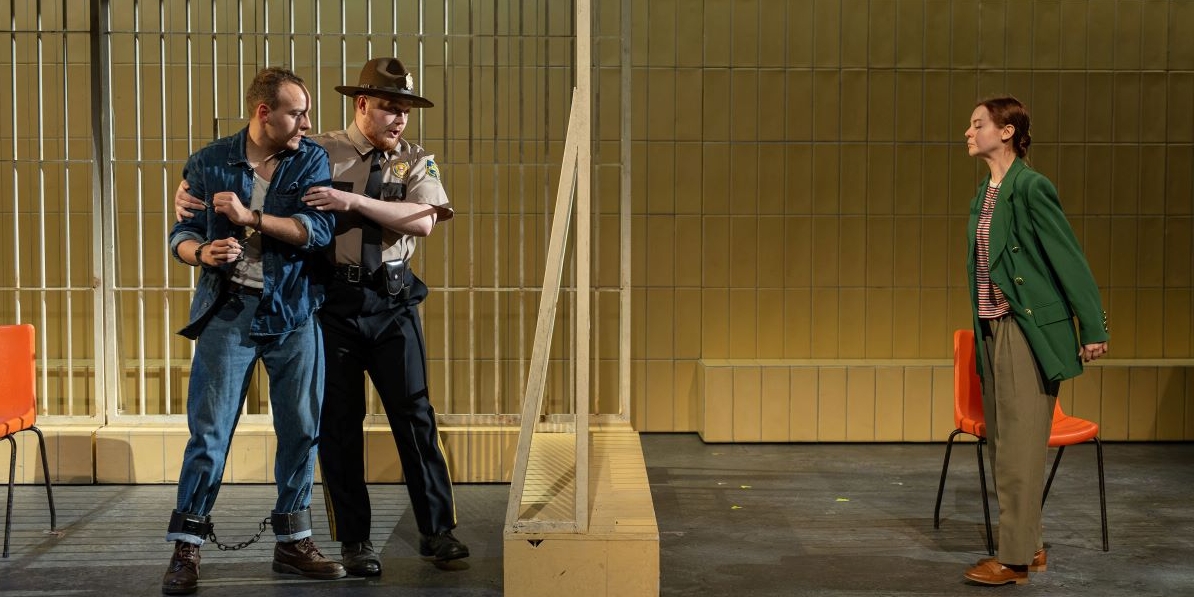Jake Heggie’s opera ‘Dead Man Walking’ is a bold contemporary choice for a student conservatory to make, but one that is fully justified on this showing. This is a long, perhaps too long, evening, but the forces and resources of the Guildhall School are more than equal to its three-hour length, and the subject matter has not dated at all since its premiere in 2000 in San Francisco. It is really surprising that this is in fact the UK premiere of the piece, which only adds to the credit that attaches to this production.
The opera derives from the memoir of Sister Helen Prejean, who began her work in projects for children in New Orleans, and who then moved on to befriend prisoners on death-row in her home state of Louisiana. The story is probably best known from the 1990s film starring Susan Sarandon and Sean Penn. The opera conflates and concentrates these experiences into one fictional convict, Joseph De Rocher, who has committed a rape and double murder of two teenage lovers. Sister Helen sees it as her mission to oppose the death penalty because of the way it brutalises all involved, and to seek confession from the perpetrators ahead of execution so that they may face up to their crimes and embrace the possibility of forgiveness and redemption. It is a great strength of the libretto and the music that they both recognise the scale and difficulty of these issues without assuming the audience’s engagement with Sister Helen’s Christian faith. There is no room for equivocation in recognising that retribution versus forgiveness and finding a just measure in social punishment are issues all of us need to reflect upon.
Heggie’s music is accessible, arranged to be supportive of the singers, and well capable of powerful orchestral interludes to cover changes of scene and mood. The crowd scenes often remind you of the sound world of Britten’s ‘Peter Grimes.’ Dominic Wheeler guides his large orchestral forces with care and authority, and despite a short technical hitch on the first night, Martin Lloyd-Evans’ production moves swiftly through the gears with a set design from Anna Reid that allows for a flow through the multiple scenes with relative ease. The pace flags a bit in the second half where many of the arguments seem to be coming around again and Sister Helen seems to move to the margins of the action, as the preparations for execution gather pace. This is the point at which some judicious cutting in the libretto might strengthen the dramatic force of the argument.
There is double-casting, and what follows relates to the first cast. At the heart of the action is the relationship between the two singers inhabiting the characters of Sister Helen and Joseph de Rocher. These are admirably taken by Alexandra Meier and Michael Lafferty-Smith. Both these roles are huge in length and emotional range. The success of the production depends on their separate journeys and on the chemistry of their interaction. Meier’s passionate advocacy and self-doubt shine through notably and Lafferty-Smith finds eloquence both in anger, self-hatred, and – ultimately – contrition. He also importantly stops short, as does the writing, in making De Rocher a sympathetic character, which he self-evidently is not. In his writing for these two roles, Heggie is particularly insightful in devising short, emotionally distinctive arias which enable each to reveal many different nuances of character and wrestle with real dilemmas.
Among the supporting roles Nancy Holt, as De Rocher’s mother, entirely and obstinately convinced of his innocence, stands out. In her statement to the parole board, an admirable ‘scena’ in its own right, her apparently fragile but steely purity of tone makes a great impact; and so too does Lorna McLean as Sister Rose, a warm, companionate voice of caution and counsel to Sister Helen. It is important both dramatically and ethically that the parents of the murdered teens get their due, and the quartet of young singers who register their anger and protest against what they see as liberal naivety, do a fine job in getting across the position of the family victims of violent crime, too often neglected. Parts for fellow nuns, prison staff and prisoners are skilfully and plausibly undertaken.
While I have some questions over the work itself, the boldness of vision and conviction behind this choice of work does credit to all involved and we can only hope that further productions of this thought-provoking piece will follow from it. For how can opera still aspire to and deserve the title of ‘grand’ at all if it does not use all its resources to reflect on matters of life and death?

